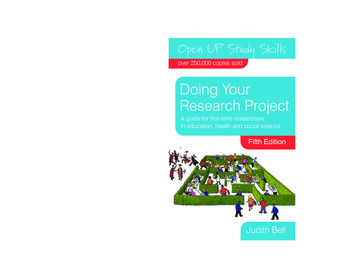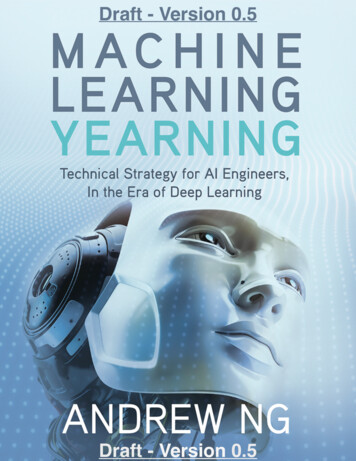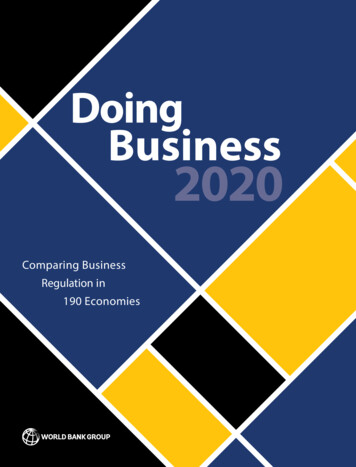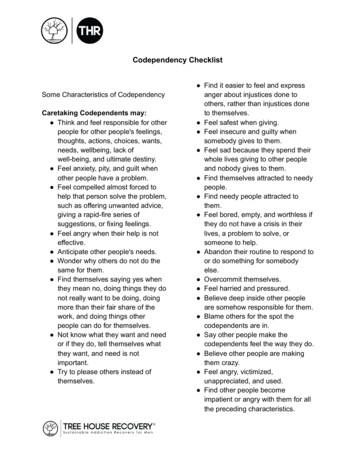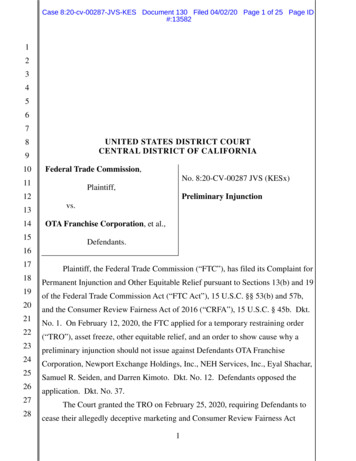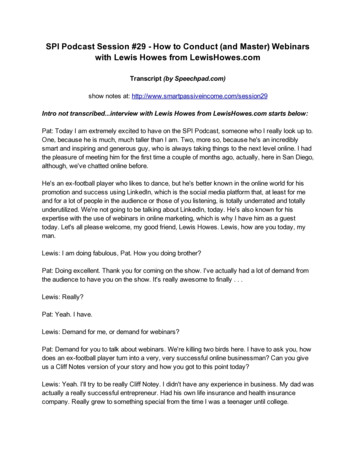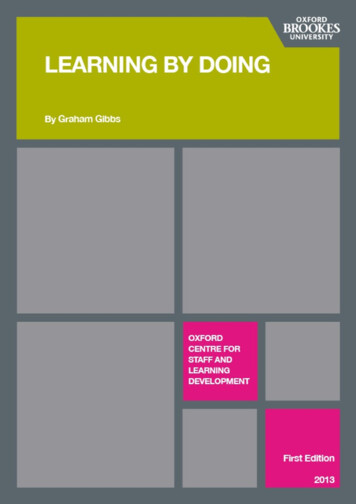
Transcription
Learning by Doing, A Guide to Teaching and Learning Methodsby Graham Gibbs (1988) and is reproduced with his permissionby the Oxford Centre for Staff and Learning Development, OxfordBrookes University, Wheatley Campus, Wheatley, Oxford, UK,OX33 1HXbrookes.ac.uk/services/ocsldThis work is licensed under the Creative Commons AttributionNonCommercial 3.0 Unported License. To view a copy of thislicense, visit creativecommons.org/licenses/by-nc/3.0.ISBN (Kindle Version) 978-1-873576-86-1ISBN (ePub Version) 978-1-873576-87-0
About Learning by Doing'Learning by Doing: a guide to teaching and learning methods'was first published in 1998 by the Further Education Unit atOxford Polytechnic, UK (now the Oxford Centre for Staff andLearning Development at Oxford Brookes University). The bookwas the result of a collaborative project between Graham Gibbsof Oxford Polytechnic and Bob Farmer and Diana Eastcott ofBirmingham Polytechnic (now Birmingham City University).In 2001 the book was made freely available online in a series ofwebpages by the Geography Discipline Network, hosted by theUniversity of Gloucestershireat http://www2.glos.ac.uk/gdn/gibbs/index.htmThe reflective learning cycle presented in the book models howlearners can link theory and practice through engaging in acyclical sequence of activities: describing, feeling, evaluating,analysing, concluding and action planning. This model has beenparticularly influential in teacher development programmes and inprofessions allied to medicine.About the authorFor 17 years Professor Graham Gibbs contributed to OxfordBrookes' reputation for excellent teaching. He was Head of theOxford Centre for Staff and Learning Development at OxfordBrookes University, and subsequently Director of the OxfordLearning Institute at Oxford University. He retired in 2007, after acareer in which he founded the Improving Student LearningSymposium and the International Consortium for EducationalDevelopment in Higher Education. Graham's national andinternational efforts to develop university teaching have beenrecognised with a National Teaching Fellowship from the HigherEducation Academy, an Honorary Doctorate from SheffieldHallam University and an Honoris Doctoris Causa from theUniversity of Utrecht.
ContentsAbout Learning by DoingPreface to the online edition (2013)Preface to the first edition (1998)ForewordChapter 1: IntroductionWhy use this guide?How to use the guideIs this guide enough?Chapter 2: Experiential learning theoryOverview of experimental learning theoryChapter 3: Learning stylesChapter 4: Practical methods to implement the experientiallearning cycle4.1 Planning for Experience4.2 Increasing awareness of experience4.3 Reviewing and reflecting upon experience4.4 Providing substitute experiencesChapter 5: Case studies of the application of experiential learningmethods5.1 Self-assessment of welding skills5.2 Self-directed learning in office practice5.3 Computer-based simulations in biology5.4 A training course for new lecturers in higher education5.5 "Thirty Second Theatre"5.6 Communication skills on a Basic Nursing course5.7 Self-directed development for further education lecturers5.8 The use of learning journals in engineering5.9 Experience-led learning on the City and Guilds 730Chapter 6: Learning to use experiential methods6.1 Assumptions about using experiential learning methods
6.2 Problems with experiential learning methods6.3 Advice on running the workshops6.4 Workshop 1: Learning sequences and - experiential learning6.5 Workshop 2: Learning styles6.6 Workshop 3: Teaching and learning methods for experientiallearning6.7 Workshop 4: Case studies in experiential learning6.8 Workshop 5: Course design for experiential learning6.9 Experiential learning: A one-day workshop
Preface to the online edition (2013)‘Learning by Doing’ has been a hugely influential text in education.In particular the reflective cycle described here has been widelyadopted by those studying, practising and teaching the skills ofcritical reflection. It has become a seminal text for health careprofessionals, staff developers and higher education teachers,and remains a recommended text on reading lists to this day.OCSLD are proud to release an online version of ‘Learning byDoing’ freely to the worldwide education community and we aregrateful for Graham’s support in doing so. I hope you find ituseful.Rhona SharpeHead of Oxford Centre for Staff and Learning DevelopmentOxford Brookes University, UKJanuary 2013
Preface to the first edition (1998)The guide has itself been developed through experientialmethods. Many of the methods described have been tried out inaction research projects in a wide range of contexts. Themembers of the project team used experiential learning theory toplan experiential learning sessions, carried out these teaching andtraining sessions and then held debriefings in which they reflectedon their experiences in these sessions. More formal evaluation ofmethods has also been undertaken, using interviews andquestionnaires. We have been lucky enough to be allowed to seehow others use experiential learning methods on their coursesand experienced teachers have given us detailed descriptions oftheir methods. We believe that the guide offers a cornucopia ofideas for implementing experiential learning and we are confidentthat you will find things which you can try out in your own teachingand training.We would like to thank the following people for their help, cooperation and ideas in the preparation of this guide:John Alexander, John Covell, John Cowan, Trevor Habeshaw,David Jaques, Tony Kelly, Paula McGee.The "Learning Through Doing" Project team:Bob FarmerDiana EastcottGraham Gibbs
ForewordThe relationship between theory and its practical applications hasbeen at the top of the education and training agenda for a decadeor so. Traditionally, teachers have seen it as their job to teachlearners how to apply theory, which they may well have learned ina very different context, either on the job, or in some practicallycontrived context which simulates aspects of the real worldexperience.However, as this manual suggests, this may be to put the cartbefore the horse, since many, if not most, learners seem tobenefit from being able to draw on their experience throughopportunities for reflection and concept development, and toreapply to new experience what has become a much clearerunderstanding based on competence of which they can trulyclaim ownership. The suggestion is therefore that learners oughtto be using practice in order to develop and test theory and notthe other way round.It is further suggested that most learners have a wealth ofexperience to draw on, which, however much lip-service is paid toit, tends to get sadly neglected even in the most carefullydesigned learning programmes. This is of course particularly trueof adult learning programmes of all kinds, including staffdevelopment.In the light of the current debate about the acquisition ofcompetence in the workplace, this manual raises afresh someinteresting questions about the merits of real versus simulatedexperience, and about the role of further education and training inthe process of developing learners. It suggests a multitude ofways in which open-minded teachers can try out for themselvesthe merits of the experiential approach. It allows newcomers tothe field to dip their big toes gently in the water, without feelingthat a total conversion process is all that will achieve results. Itallows teachers accustomed to a classroom and workshopcontext an opportunity to extend their practice little by little, so
that they may begin to approach the perhaps new role ofworkplace tutor and assessor with confidence. It also offers someinsight into the evaluation of such learning and testing processes,a topic likely to occupy educationalists considerably in the nextfew years.The manual is likely to be of particular interest to staff developersand tutors in further education and training.FEU (Further Education Unit) will be interested to receivefeedback from any colleges which decide to trial-test thecontents.It remains to express our thanks to the Birmingham PolytechnicEDU team who developed the manual with the able support ofGraham Gibbs, whose capacity for creative thinking contributedsubstantially to the finished result.Elizabeth SimpsonDevelopment Officer, FEU
Chapter 1Introduction
Why use this guide?Most teachers and trainers seem to believe that you learn best bydoing. But how is this rather general belief to be put into practice?In particular:· What ideas or theories are there to help us to explain andjustify the belief that we learn best by doing?· Does everyone learn by doing in the same way or to thesame extent?· What teaching and learning methods are there for us to usewhich involve learning by doing?· If our courses are redesigned to involve more learning bydoing, what might they look like?· How is it possible to change our teaching to involve learningby doing when we are surrounded by constraints?· What can go wrong?· How can we encourage our colleagues to change theirteaching to involve more learning by doing?This guide addresses these questions in a direct way withstraightforward explanations and concrete examples. Itsemphasis is on practical teaching and learning methods forimplementing learning by doing.'Learning by doing', and the term 'experiential learning', arecommonly used to refer to several different aspects of learning.This guide is not concerned with the assessment of 'priorlearning': learning experiences which have taken place beforelearners enroll on courses and which are taken into account in theassessment of the course or the granting of exemptions fromcourse components. Neither is this guide directly concerned withexperiential learning in terms of personal development and thehuman potential and growth movements. Although aspects ofpersonal development, such as the growth of autonomy, areimportant to learning by doing, it is a massive and separate topicand deserves its own separate guide.
How to use the guideThe guide is written to be used as a resource rather than as abook to be read right through. Sections 4 and 5 are full ofpractical ideas for teaching methods and course designs and aremeant to be dipped into. Sections 2 and 3 provide the underlyingideas and Section 6 provides follow-up information if you wish toapply the ideas.Section 2 provides an explanation of experiential learning theoryand the experiential learning cycle. It offers a way of structuringand sequencing learning to improve the effectiveness of learningfrom experience.Section 3 describes the ways in which individuals differ in theirpreferred learning styles and in the way they handle theirexperiences. It explains some of the implications of experientiallearning styles.Section 4 describes a wide range of teaching and learningmethods which implement each of the stages of experientiallearning and which take learners round the experiential learningcycle.Section 5 contains case studies of the use of experientiallearning theory in course design and of the way experientiallearning sessions are run. If you take experiential learningseriously, this is what your teaching may come to look like.Section 6 contains exercises and materials to support staffdevelopment workshops designed to introduce teachers andtrainers to experiential learning. It summarises the mainassumptions underlying the adoption of experiential learningmethods and lists the more common problems encountered inintroducing experiential learning methods.
Is this guide enough?No it isn't! Inevitably the descriptions of teaching methods arebrief and lack subtlety: sources are suggested for further reading.But reading on its own is not enough. Section 6 offers workshopsfor introducing experiential learning methods to teaching staffexperientially rather than through passive reading alone. But it isnot until methods are tried out and teachers gain first handexperience of their use that their full value can be appreciated. Tolearn about experiential methods you have to use them andexperience them, reflect on their use and experiment again.Ideally this should be done co-operatively so that teachingexperiences can be discussed. Probably the ideal use of theguide would be on an in-service teacher training course wherethose on the course tried selected methods out in their teachingand then discussed what happened.
Chapter 2Experiential learning theoryIt is common for courses to be described as either practical ortheoretical: as either involving doing or involving thinking.Learning is seen to take place either 'on the job' or in theclassroom. Even in courses which contain both elements theytend to be sharply divided. An academic teacher may presenttheory in a lecture in the classroom whilst a practical supervisor isin charge of the follow-up practical experience in a workshop.It is also common for both types of course to have limitedsuccess.It is not sufficient simply to have an experience in order to learn.Without reflecting upon this experience it may quickly be forgottenor its learning potential lost. It is from the feelings and thoughtsemerging from this reflection that generalisations or concepts canbe generated. And it is generalisations which enable newsituations to be tackled effectively.Similarly, if it is intended that behaviour should be changed bylearning, it is not sufficient simply to learn new concepts anddevelop new generalisations. This learning must be tested out innew situations. The learner must make the link between theoryand action by planing for that action, carrying it out, and thenreflecting upon it, relating what happens back to the theory.It is not enough just to do, and neither is it enough just to think.Nor is it enough simply to do and think. Learning from experiencemust involve links between the doing and the thinking. The fourstage model of learning by doing which is elaborated below is thatof Kolb. Quite a few theorists have proposed cyclical models toexplain how people learn from experience, but they all share theimportant features of Kolb's model which is itself derived from
Lewin. Learning from experience involves four stages whichfollow each other in a cycle, as in the following diagram.The terms used here as labels for the four stages come fromKolb's Experiential Learning Theory, and placed in thissequence they form the experiential learning cycle. The cyclecan be entered by the learner at any point, but its stages must befollowed in sequence.EXAMPLE 1A trainee nurse might start learning how to lift a patient by takingpart in supervised practice with a dummy, which would giveexperience of (a simulation of) what it is like (stage 1 in thediagram below).The charge nurse might then ask: "How did that feel? What mightyou have done differently?" to encourage the nurse to bereflective about the experience (stage 2).That night the nurse could look up, in a textbook, how to liftpatients and read about the reasons for doing it in particular ways(stage 3).Next day, confronted with a real patient to lift, the nurse wouldthink: "As a result of what happened yesterday, and because ofwhat I read last night I ought to do it like this" (stage 4). Thiswould provide a new experience and start the nurse on the next
learning cycle.EXAMPLE 2This learning cycle is exactly the same as that involved in carryingout experimental work. A chemistry course might involve thesequence of learning activities illustrated below:Taking notes in a lecture about a type of chemical reactionDesigning and running an experiment to test whether this type ofreaction occurs with a particular group of elementsGaining the experience of seeing what happens in the experimentLooking at the results and comparing these with others' results
Discussing possible explanations of these resultsDesigning and running an experiment to test these alternativeexplanationsGaining the experience of seeing what happens in this experimentLooking at the results and comparing them with previous results and so on, round and round the cycle, until an adequateunderstanding of the nature of the chemical reaction has beenarrived at.Exercise 1Take a section of a course or a teaching or training session whichyou are responsible for and try to describe the sequence oflearning activities involved in terms of the stages of theexperimental learning cycle. Use the two examples above asmodels, and use this diagram and the space below it to plot thesequence.Stage 1:Stage 2:Stage 3:Stage 4:Stage 5:Stage 6:etc.
Which stages of the experiential learning cycle have been missedout (if any)? What could you add to complete the cycle(s)?
Overview of experimental learning theoryThe following list of points may help to clarify what experientiallearning is, and what it is not:· Learners are involved in an active exploration ofexperience. Experience is used to test out ideas andassumptions rather than to obtain practice passively.Practice can be very important but it is greatly enhanced byreflection.· Learners must selectively reflect on their experience in acritical way rather than take experience for granted andassume that the experience on its own is sufficient.· The experience must matter to the learner. Learners mustbe committed to the process of exploring and learning.· There must be scope for the learner to exercise someindependence from the teacher. Teachers have animportant role in devising appropriate experiences andfacilitating reflection. However the transmission ofinformation is but a minor element and the teacher cannotexperience what the learner experiences or reflect for thelearner.· Experiential learning is not the same as 'discovery'learning. Learning by doing is not simply a matter of lettinglearners loose and hoping that they discover things forthemselves in a haphazard way through sudden bursts ofinspiration. The nature of the activity may be carefullydesigned by the teacher and the experience may need to becarefully reviewed and analysed afterwards for learning totake place. A crucial feature of experiential learning is thestructure devised by the teacher within which learning takesplace.· Openness to experience is necessary for learners to havethe evidence upon which to reflect. It is therefore crucial toestablish an appropriate emotional tone for learners: onewhich is safe and supportive, and which encourageslearners to value their own experience and to trustthemselves to draw conclusions from it. This openness maynot exist at the outset but may be fostered through
successive experiences of the experiential learning cycle.· Experiential learning involves a cyclical sequence oflearning activities. Teaching methods can be selected toprovide a structure to each stage of the cycle, and to takelearners through the appropriate sequence.Sections 4 and 5 provide practical advice on appropriateteaching methods .
Further readingBoud, D., Keogh, R. and Walker, D. (Eds.) Reflection: TurningExperience Into Learning Kogan Page, London. 1985.Kolb, D. A. Experiential Learning - Experience as the Source ofLearning and Development Prentice- Hall, New Jersey. 1984.
Chapter 3Learning stylesJust as courses may be seen to be either mainly practical ormainly theoretical, so individuals may have particular preferencesin their learning. While one person might prefer to formulate plansand define potential problems, another might prefer to get on andcarry out the plans. There are distinct learning styles associatedwith each of the stages of the experiential learning cycle.These differences in style were illustrated graphically in acomputing course. At the start of this computing course thestudents were set an open-ended computing problem to work onalone over the next four weeks. They then met to comparesolutions to the problem, but also to compare the different waysin which they went about working on the problem. Three of thestudents displayed dramatically different styles:Student A went straight to a computer keyboard and startedkeying in segments of a program. She didn't analyse the natureof the problem. As soon as it became apparent that theprogramming routines being written didn't work, new routineswere written out and immediately tested in a trial and error way:mostly error. This student had created dozens of programmingroutines, none of which got close to solving the problem. Sheseemed not to learn from her mistakes.Student B appeared to start off like student A, going straight tothe keyboard. He selected a procedure which he knew andimplemented it. He wrote an extensive, detailed and completeprogramme which ran successfully, but which solved a problemquite different from the one which was set. He was unaware thathe had tackled the wrong problem because he was so busygetting on with the task.Student C became intrigued by the problem itself and its
underlying features. She started reading about this kind ofproblem and the reading led her into related areas which alsocontained intriguing problems. She could talk animatedly aboutthe topic in general in an abstract way but hadn't even startedwriting any programming code to produce a solution.In terms of the experiential learning cycle, these students werestuck at one part of the cycle to the virtual exclusion of the otherthree.Exercise 2See if you can place the three students on the cycle in thediagram below by identifying which aspects of the experientiallearning cycle each exhibits and misses out.Locate students A, B and C on this diagram, and explain yourreasons for each.We have looked at these three students in the diagram below.We have done so by thinking about why each of these studentsfailed to solve the problem.
Student A failed because she experimented without learning fromher mistakes. She didn't start from an analysis of the problem(conceptualisation) and didn't seem to reflect on the outcomes ofher experiments (reflection). All she did was try things out ( activeexperimentation) and change tack when she experienced thingsnot working out (experience). She might be quite good at practicalwork and experimentation, but she won't learn from this.Student B failed because he didn't even notice that his solutionwas solving the wrong problem: he was not aware of his ownexperience. This style characteristically involves "prematureclosure" or rushing to a single solution without generating orconsidering alternatives. He might be very good at workingthrough procedures which apply theory to a specific situation , butthis won't necessarily help him.Student C might be quite creative and admirably thoughtful aboutwhat she is doing, but until she gets down and tries her ideas outin practice she isn't going to get anywhere. At some point she hasto narrow down the scope of the possibilities in front of her andget her hands on the keyboard and see what happens when shetries things out.In order to learn effectively from experience it is necessary toutilise the abilities associated with each of the four learning stylesin turn. These abilities are illustrated in the diagram below:
Rather than have extreme styles, therefore, it is preferable to beadaptable and to operate in the style appropriate to eachsuccessive stage of the experiential learning cycle at differentstages in a learning task. It can be valuable for students torecognise their own habitual learning style and to recognise thecharacteristics of learning tasks as this may help them to becomemore flexible in meeting the varied demands of learning situations.The students of computing were encouraged to discuss theirlearning styles and were then put in project groups which mixedstyles so that students experienced the ways in which othersworked. Each week the teaching session was started with adiscussion of how the project groups had gone about tacklingtheir tasks in order to raise students' awareness of the alternativeapproaches possible.Several questionnaires and checklists are available to enable thequick diagnosis of learning styles. There are numerous otherframeworks for making sense of differences in learning style butthe framework outlined here is the most useful one in relation tolearning by doing.
Further readingFor a short experiential learning styles inventory and explanationof learning styles:Kolb, D.A.,Rubin, I.M. and McIntyre, J.M. OrganisationalPsychology: An Experiential Approach Prentice Hall. 1974For a more extensive questionnaire and analysis of learningstyles:Honey, P. and Mumford, A. The Manual of Learning Styles. PeterHoney, Maidenhead. 1986.For a learners' guide to learning styles and how to change yourlearning style:Honey, P. and Mumford, A. Using Your Learning Styles. PeterHoney, Maidenhead. 1986
Chapter 4Practical methods to implement theexperiential learning cycleThe practical teaching and learning methods described in thissection are categorised according to the phase of the experientiallearning cycle with which they are primarily concerned, asillustrated in the diagrams below:4.1 Planning for experienceThis section is concerned with methods for preparing learnersprior to experiences so that they make the most of thoseexperiences: for example through action planning and thenegotiation of learning contracts.4.2 Increasing awareness of experience
This section is concerned with methods for heightening learners'awareness of their experiences so that they notice more andhave more material upon which to reflect afterwards: for examplethrough the use of log books.4.3 Reviewing and reflecting upon experienceThis section is concerned with what happens after learningexperiences and how learning points can be drawn out throughstructured reflection: for example through the use of videorecordings and self-assessment.4.4 Providing substitute experiences
This section is concerned with ways of providing classroombased experiences as substitutes for work or other experience:for example through the use of role plays.
4.1 Planning for Experience4.1.1 Action plansAn action plan is simply a written list of things to do. A traineepainter could draw up an action plan for the sequence of tasksand decisions which need to be made in decorating a room. Thiscould be done by:· reviewing notes from a classroom session concerned withgeneral rules concerning how to undertake decorations (e.g.the order in which wallpaper should be hung) and· applying these general principles to the job in hand. Such alist could be kept at hand in order to keep a check on theexperience of undertaking the decoration task.4.1.2 Setting objectivesAlthough it is common for teachers to set objectives for learners,learners can also set objectives for themselves. Beforeembarking upon an experience of some kind, learners can sitdown and write out: "After this experience I will be able to " andspecify what will have been learnt. This can be an excellent wayof focusing attention on important aspects the experience byproviding a reminder of what function the experience is supposedto have. Such a set of objectives (it may only need to be a few tobe useful) can also provide a valuable aid to reflection and selfassessment after the experience.4.1.3 Designing experimentsIn many practically based scientific and technical subjects,learners undertake experimental work in the laboratory orworkshop . It is common for the teacher to design theexperiments for the learners to execute, sometimes givinglearners little to do except follow instructions. For learners to bemore involved in experimental work and more alive to theirexperience of it, it is important for them to be involved in at least
some aspects of the experimental design. It may be possiblesimply to pose a problem, ask "How are you going to be able tomeasure X or find a value for Y?" and leave the learners todesign their own experiments. It may be that you have to providemost of the experimental design, but can leave some detailsunresolved, to be discussed and agreed before work begins. Itmay be that for practical reasons you have to have preparedequipment and facilities in advance and there is little scope forvariation. Nevertheless there is still scope for students tospeculate about possible experimental designs beforehand sothat the actual experimental design is seen as one of a range ofpossibilities instead of simply taken for granted as the design. Asoutlined in Section 2, scientific method is fundamentally the sameas the experiential learning cycle, and learners should not missout stages merely for the sake of convenience or saving time.4.1.4 Observation checklistsMuch experience is gained through seeing how others do things,or what goes on in situations. However, if you are new to asituation, you may not know what to look for and it can be veryeasy to lose attention and to notice very little. This problem canbe eased with the use of a simple observation checklist which liststhings to look out for and perhaps asks for the recording ofevents and how often they happened.Ready-made observation checklists of some sophistication areavailable for example for observing school teachers in action.Simple checklists can be devised by the learners themselves. Forexample, prior to a small group of trainee nurses seeing a StaffNurse administering medication on a ward, there could be a shortdiscussion of what to look out for, and a brief checklist drawn up.After the round, this could be used to structure a short discussionwhich encourages reflection on what had been seen, and whatsignificance these observations had.The example of an observation sheet below is for use inobserving and giving feedback on group leaders or committeechairpersons. The sheet identifies categories of leadership
behaviour, gives examples or definitions of each, and has spacefor recording the number of occasions on which each type ofbehaviour was observed
'Learning by Doing: a guide to teaching and learning methods' was first published in 1998 by the Further Education Unit at Oxford Polytechnic, UK (now the Oxford Centre for Staff and Learning Development at Oxford Brookes University). The book was t

